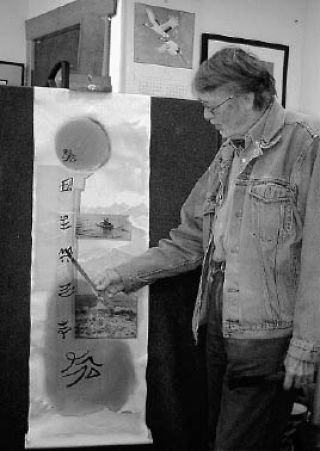by Leta Marshall
When he was young and considering careers, Richard Singer thought he wanted to be a dentist.
“Thank God that didn’t work out,” he says now. The day of awakening came when he found out he was terrible at zoology, after thinking he would be good at it, so he switched to the study of art at the University of Washington and Cornish. With a family to support, he spent his working days operating a 10,000-byte computer to maintain databases and produce reports and insurance renewal notices.
“It was like solving puzzles,” he says. “I was good at it.”
In the 1970’s, as computers quickly grew more sophisticated, Richard began using them to create graphic art, spending his weekends painting the old-fashioned way, with brushes on canvas. He still uses his home computer to make eye-catching posters for art and music events.
Richard was born and raised in Seattle and lived there 50 years. As a child, encouraged in his artistic pursuits by family and teachers, he made linoleum block prints, painted, and even created art for local newspapers. As an adult, he took his first watercolor class at age 33 and was captivated by the medium, and even served as president of the Northwest Watercolor Society for a year in 1991. But he was also doing art in other media, and because of the Watercolor Society’s rules, he couldn’t enter their shows with what he thought was his best work.
As he developed his own style, he says, “I realized I didn’t want to be a photorealistic painter.” Rather, he learned to love the unexpected outcome. “I like the surprises – they’re the main thing for me.”
His latest work is a collection called “The Live Sea Scrolls.”
“I got kind of excited about this series,” he says.” With a scroll, you feel like it’s going to teach you something.”
The raw canvas scrolls may be stained with tea for an aged effect; old photos are transferred onto the canvas, and images and calligraphy are added in acrylic paint and ink. Fascinated by the different symbols people use to express words and ideas, Richard has developed his own Kanji-like alphabet of characters, and here they are executed in dense black brushstrokes. (For another series of works, he developed his own blend of true Egyptian hieroglyphics and look-alike symbols.)
The photos he uses are most often from his own huge collection and many depict members of his own family. He sits in bed going through boxes, pulling out those pictures that strike his fancy or suggest a theme.
“I probably think about a painting longer than I spend painting it,” he says.
He scans the photos into his computer, so the originals are never harmed, then alters them and prints different versions until he gets what he wants. The printed images are transferred onto canvas using heat. Results of this process are unpredictable, but missing corners and scraped-looking patches are fine with Richard.
“I don’t even try for a squeaky clean transfer,” he says.
Richard also makes intriguing collage shadowboxes. “I can present this little tiny world inside a box…but holy smoke, are they time burners!”
One of his teachers at Cornish told Richard’s class, “Every one of you can be a master, if you keep at it.”
That encouragement was very valuable to him, Richard says, along with the realization that “You don’t have to be a draftsman. I had to learn not to get so into every detail.” He sometimes uses his non-dominant right hand to loosen his control.
Richard doesn’t show his work in galleries, partly because “they end up wanting you to keep doing the same thing,” he says. But he is delighted, if even a little surprised, that he’s sold a lot of paintings. He is constantly inventing and discovering, and his good-natured, playful approach might be applied to almost any pursuit, even by us non-artists.
“When I get a new idea and try to solve the problems, that’s the most fun,” he says.
Richard’s work can currently be seen at Lopez Center for Community and the Arts in a Lopez Artist Guild show that runs until June 24. Call 468-4033 for an appointment to visit his studio.




